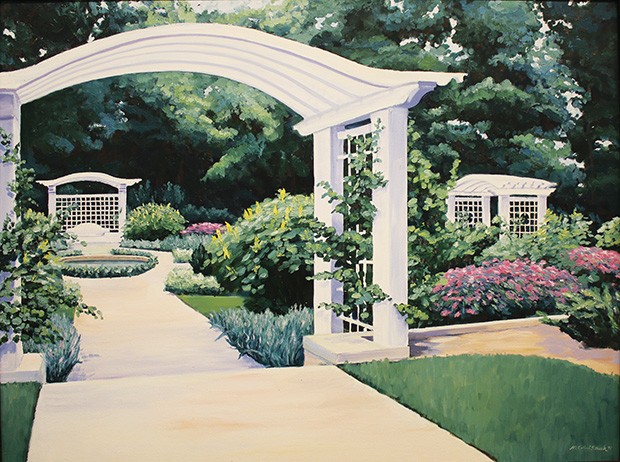
Some cities sponsor “art hops” where area residents “hop” between various venues on the same night to see a variety of art exhibits. In Springfield the Springfield Art Association (SAA) Collective is offering a multi-week “hop” between two venues to enjoy works by women artists. The two-gallery exhibit – one at the Springfield Art Association (SAA) Collective Main Campus M.G. Nelson Family Gallery and the other at the SAA Collection H.D. Smith Gallery in the Hoogland Center. It is called “The First Ten Years.” Running until Aug. 31, it showcases works of the artists from the first decade of the 40-year-old Women’s Art Alliance.
“The idea emerged after a meeting where a group had discussed generating a memorial frieze at the Hoogland site of women who had been a part of the early efforts in displaying women’s art,” says Betsy Dollar, executive director of the Springfield Art Association. “The idea grew to try to locate the women and put on a show.”
It took over a year to locate artists. Ruthann Mazrim helped with the efforts. “Several of us Googled artists’ names. We went through old brochures of some of the art shows to determine who had exhibited in the first 10 years. Many women have scattered to various areas of the country. Some still live here.”
A letter was sent to the artists or to family members of women who were deceased. Artists were asked to provide two pieces of their work, one from the first 10 years and one more current. Many were interested. Crates filled with paintings, ceramics, etc. arrived from Alaska, New York, Arizona, Louisiana Florida and California. Some of the artists no longer had an original piece from the 1980s, but people in Springfield contributed pieces they had purchased over the years.
A piece from the 1980s is displayed next to a more recent piece, and it is interesting to see how an artist has evolved and changed, even going from landscape to abstract.
The organizers wanted to honor those artists who are now deceased. So, there are two parts of the exhibit that honor them. The BACKdoor gallery, an area outside the back door of the main gallery, showcases some of the art from these deceased women. In the main gallery, names of the deceased have been stenciled as a frieze near the ceiling.
In 1979 the Women’s Alliance formed when two organizations united – The Rape Information and Counseling Center and the Sojourn House, the shelter for women who faced domestic violence. With a $20,000 grant from the Presbyterian Church USA, the Women’s Alliance House at 1011 N. Sixth opened to serve women. Polly Poskin, who served as the director, says, “We wanted to provide programs and workshops for women, including ways for women to expand their employment opportunities, for those who came to the shelter or the Rape Counseling Center. We brought in experts to talk about various issues to help women. We even had soccer and softball teams.”
Poskin began considering how she could combine her interest in the arts, her desire to help women and her experience with several college friends who had pursued their own art. These sparked her idea to form the Women’s Art Alliance to promote local women artists. A Holiday Show and Sale in December 1980 showcased 16 artists, some of whom had never before had the opportunity to exhibit their work. Its success spurred more interest, and the group began monthly art exhibits at the Alliance House. The artists donated 20% of their proceeds to the Women’s Alliance.
Dollar says the Springfield group may not have fully known about the efforts happening across the country at the time. Other groups like the New York A.I.R. (Artists in Residency) Gallery, and WARM (Women Arts Registry of Minnesota) were just two groups working to help women gain access to showing their works, something that had been offered only to men.
In 1985 the Women’s Art Alliance separated from the original Alliance, becoming a nonprofit. By 1990 Springfield had embraced the group as a part of the art community. In 1993, after three men were asked to join the membership, discussions began to rename the group. Thus, in 1995 the Prairie Art Alliance (PAA) was established. The late Pat Anderson, respected artist and teacher, served as board president. In 1996, the PAA rented the Fleischli house on the grounds of the Art Association and established a classroom and gallery, and volunteers provided hours of help. PAA moved into the H.D. Smith Gallery at the Hoogland Center for the Arts in 2004.
In 2016 PAA merged with the SAA and is now called the SAA Collective. The Springfield Art Association continues to offer education and classes; some of the SAA Collective artists are part of the faculty.
With over 80 artists, The Collective exhibits art in all media. Its works are sold throughout North America.
Mazrim provided a piece from the 1980s and one she did a year ago. She says the WAA, “offered a way to be around other women artists who encouraged exploration.” Artist Priscilla Kluge says, “Not only was it a chance to bounce ideas off others, but also it offered a way to share the balancing act of making art while raising children. Opportunities for new shows and actually selling your work were a huge boost in doing my art.”
A second exhibit, separate from the WAA but connected in a way, will run Sept. 6-28 at the SAA Collective M.G. Nelson Center. “Art as Advocacy: Promoting Equity and Social Justice from Women” will be a nationally juried exhibit showcasing the evolution of women in the arts.

